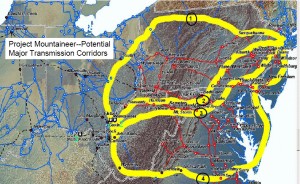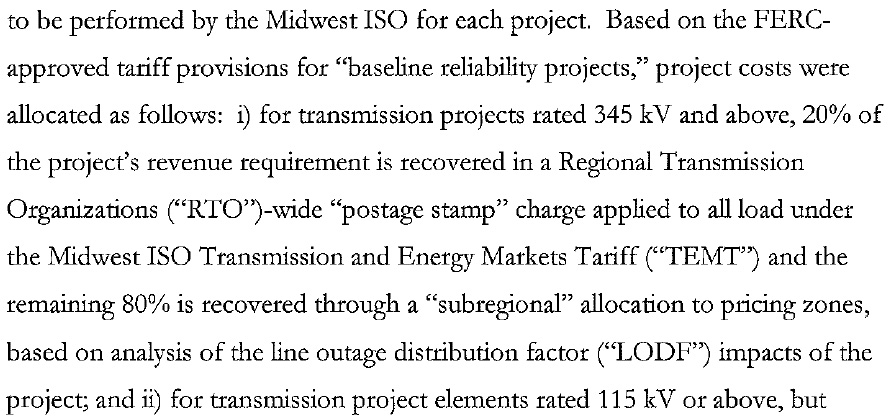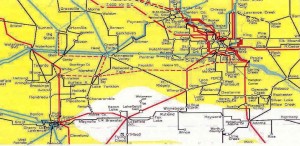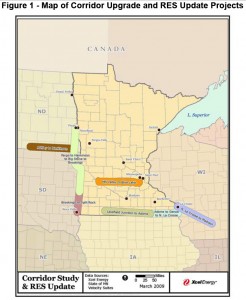PSEG’s Izzo disses Midwest Transmission
September 30th, 2009
Did I hear that right???
I’m fighting with PSEG out in New Jersey, representing Stop the Lines on the Susquehanna Roseland transmission line. PSEG can be vile… but on this one point, PSEG’s Ralph Izzo is right. Now, if we can just get him to be consistent.
Transmission is not rocket science, and Izzo statements reflect that he understands what Midwest transmission is all about — $$$ and coal. He and PSEG have joined the many who are standing up to Midwest transmission plans. Now, is the Midwest paying attention? As PUC Chair Boyd said at the last Legislative Energy Commission meeting, they need a solid business plan. Guess what — they don’t have one, DUH!!!! There’s no market (Doesn’t Chair Boyd or anyone else in the room think there’s something a little too cozy about Boyd advocating for transmission with MISO???).
Today at a conference, PSEG’s Izzo let loose and let them have it:
Here’s some propaganda from PSEG:
In short:
Now just who does this sound like?!?!?!?! Hilarious… dig this, though he’s not admitting the INTENTIONALITY of the transmission scam:
And this broad view so contradicts their Susquehanna-Roseland transmission plan, which is all about coal from Amos = it’s the NE part of “Line 1” in Project Mountaineer. PSEG, you can’t have it both ways! Let us hope that now that he’s spouting opposition to the Great Midwestern Transmission Scam he’ll see the scam of New Jersey transmission. At least we’ll now have this to use. THANK YOU, RALPH IZZO!
Big Stone II is zu ende???
September 11th, 2009
Otter Tail Power has withdrawn from Big Stone II. Odd way to put it because Big Stone II IS Otter Tail Power. OTP was the big one left in the game and now they’re gone.
Otter Tail Power has withdrawn from the Big Stone II coal plant. Really?!?!?
Pinch me, I must be dreaming…
Here’s their post about it on their BSII site – love the euphemisims:
Big Stone II announces participant changes
Otter Tail Power Company withdraws; Project pursues new participants
In the first blurb to come over the wire, below, there’s one phrase that stands out:
I knew that financing was not happening and dependent on a big cash infusion from Bill Gates. Financing anything now is pert near impossible, hence the big cost allocation dust up for CapX lately, and Big Stone II was no exception. Who on earth, who in their right mind, would invest in a coal plant today? That falls squarely in the “HOW STUPID CAN WE BE” category, no doubt about it.
I‘ll post more as it turns up. From Marketwatch:
Otter Tail Power Company Announces Withdrawal From Big Stone II
WOW’s deal with the devil at issue
August 18th, 2009
“Wind on the Wires” and AWEA are whining and crying in the press about unfair treatment to wind generators. They do a deal with the devil to promote transmission and now are getting screwed — sorry, I won’t be hosting a pity party here!
AWEA and WOW’s FERC filing to protest MISO cost allocation proposal
To look at the full FERC docket, GO HERE TO FERC SEARCH PAGE, and search for docket ER09-1431.
“Wind on the Wires” is a subset of the Izaak Walton League – Midwest, not a separate organization. Some background here:
Years ago, the Midwest Izaak Walton League, together with MCEA, ME3 (Fresh Energy) and North American Water Office, did a deal with Xcel, and a massive “Wind on the Wires” grant was announced a couple of days later. The deal was to support a massive transmission buildout, specifically, to work to change state and federal law; to support transmission projects; to usher them through the legislature, state and federal administrative venues, to support at industry transmission planning groups; to support changes in rate recovery; to support changes in transmission need and siting criteria; and to allow transmission-only companies, all the things that Xcel wanted to roll out CapX 2020, JCSP, and whatever else is in their dreams.
Really… it’s all here:
$8.1 Million Wind on Wires grant from McKnight/Energy Foundation
This 2003 Settlement Agreement was in the Minnesota PUC’s TRANSLink docket, where Xcel wanted a transmission only company, not yet allowed in Minnesota. For the docket, go to www.puc.state.mn.us and then click on “eDockets” and search for docket 02-2152. F”or the resulting legislation, some of it, see 2005 Transmission Omnibus Bill from Hell.
So they jump through all those hoops and where are they? What happens?
Back to Cost Allocation of Transmission.
Let’s see… there was one cost allocation scheme, 50-50 split between owner utilities and generators connecting. Otter Tail Power objected and so the utilities changed it to a 90-10 split, and now “Wind on the Wires” and AWEA are screaming, whining and crying saying it has to go back. This has to do with how the utilities characterize the purpose of the line, be it for “Reliability” or “Generation Interconnection” and how costs are apportioned are different. In the CapX proceeding, the “Brookings line” was not declared, and the Fargo and LaCrosse lines were deemed “Reliability” but that’s absurd…
For “Baseline Reliability” projects here’s the cost allocation scheme:
For “Generation Interconnection” here’s the cost allocation scheme:
Ummmmm… a little more background here now that we’re talking about interconnection… does anyone remember the name of that coal plant that Otter Tail Power just got permitted to build? Oh, yeah, right, it’s BIG STONE II. And what was the name of that big honkin’ coal plant that “suddenly decided” to produce electricity rather than syngas? South Heart, yeah, that’s it. See “South Heart coal gasification — Coal on the Wires.” Both plants strategically placed to use CapX 2020 transmission. So what is the impact of this shift to Otter Tail Power and their Big Stone II project?
Here’s the Big Stone electrical link to CapX — it’s all connected:
Here’s new connector ND transmission announced April 3 — it’s all connected:
And of course, the big picture of CapX 2020 – click on it for a bigger picture to really appreciate those lines starting in the Dakotas:
Here’s an article from last week about their objections:
Wind industry protesting plan to pay for new lines
Cost-sharing proposal decried as threat to renewable energy goals
By Leslie Brooks Suzukamo
lsuzukamo@pioneerpress.com
Updated: 08/14/2009 12:01:26 PM CDT
So if “Wind on the Wires” and AWEA object to “generator pays” transmission, where it’s the generator causing the need, then they’re now in essence advocating for a different scheme for Big Stone II and South Heart coal plants too. Oh, good idea…
Here’s another one that turned up — WOW and AWEA sent out a raft of press releasees…
Wind Industry Fights Midwest Transmission Proposal to Stay Alive
by Stacy Feldman – Aug 17th, 2009
Even worse — the plan could put the nation’s renewable energy goals in jeopardy.
Currently, generators and utilities split the price paid, 50-50.
And then there’s the big issue of cost: Who would pay for it?
The MISO proposal is a local version of that long-simmering cost dispute.
FERC has not indicated whether it favors MISO’s proposal or would recommend changes.
If we can’t, we should be shot…
June 9th, 2009
Really, that’s what they said at a meeting where the operators of the Hibbing “biomass” plant were confronted with all the problems, dust, noise, neighbors fed up and bringing in the evidence. This is the plant that was violating its air permit and was fined and shut down,
but of course air permit limits were INCREASED and it reopened.
GRRRRRRRRRR. And when they were told to clean it up, given a deadline, they said:
Thanks to Charlotte Neigh for sending this in. Let’s keep an eye on this one! Ready… aim…
Commission vows to take action on dust, noise
Meeting draws more complaints from neighbors
by Kelly Grinsteinner
Assistant Editor“It’s something that’s going off in my head,” she said. “Something
needs to be done.”“Everything is so filthy,” she added. “I can’t clean it. We can’t sell
it. We’re stuck.”Linda Johnson imitated the irritating noise she hears coming from the plant.
“It’s sad when you wake up dreaming of WD-40,” she said.
“Keep yours on your side of the street, and I’ll keep to my side of the
street,” he said.
The Economist weighs in, now it’s YOUR turn!
May 4th, 2009
I’d wondered why “The Economist” had shown up in my blog stats, and now I know. But from the viewpoint of this article, it’s clear they didn’t do more than scratch the surface of transmission in the Midwest. This is “party line” all the way — I hope they’ll now take the time to read NYISO and ISO-NE’s letter of withdrawal from publication of JCSP!
YOUR TURN! Let them know what you think and why — the registration is instantaneous and easy, so COMMENT AWAY!
Spreading green electricity: A gust of progress
Apr 30th 2009 | CHICAGO
From The Economist print edition












